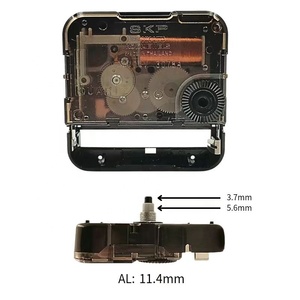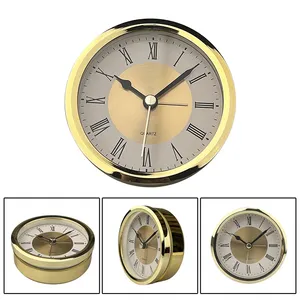(994 products available)









































































































































 Ready to Ship
Ready to Ship










 Ready to Ship
Ready to Ship



































Replacement clock mechanisms, also known as clock movements, are the internal components that drive the clock's timekeeping and movement of the hands. They come in various types to suit different styles and needs.
Quartz movements
This is the most common type of replacement clock mechanism. It uses a battery-powered quartz crystal to ensure accurate timekeeping. These mechanisms are easy to use, affordable, and low-maintenance. They are suitable for many clocks, including wall clocks, mantel clocks, and desk clocks.
Mechanical movements
Mechanical clock movements rely on winding springs, gears, and weights to keep time. They are often found in antique or traditional clocks and are prized for their craftsmanship and aesthetic appeal.
Automatic movements
Also known as self-winding movements, these are used in clocks like wristwatches that rely on the wearer's motion to wind the spring. They feature a rotor that spins with wrist movement, winding the watch.
Digital movements
Digital clock movements are used in electronic clocks that display time with numbers instead of hands. These mechanisms can power various devices, from alarm clocks to digital wall clocks.
Skeleton movements
Skeleton clock movements are a type of mechanical movement that exposes gears and other internal parts for aesthetic purposes. They are often used in decorative mantel and table clocks.
Westminster chime movements
These are special clock movements that play the Westminster chime melody on the hour or at specific times. They are commonly used in grandfather clocks and some wall clocks.
Timer movements
Timer clock movements are used in devices that count down or count up. They are commonly found in kitchen timers, gym timers, and board game timers.
Novelty movements
Novelty clock movements are designed for specialized applications, such as scoreboards or countdown clocks. They offer unique features and functions for specific purposes.
Chiming movements
These clock movements are designed to strike bells or hammers to produce sound at set times. They are commonly used in grandfather clocks and some wall clocks.
Synchronizer movements
Used in synchronized clock systems, these movements keep multiple clocks in sync using a master clock signal. They are ideal for schools, offices, and public spaces.
Different designs of clock mechanisms are available to meet various aesthetic tastes and functional requirements. These are some important design aspects to consider when choosing a clock mechanism:
Style of mechanism:
Clock mechanisms come in different styles, including traditional quartz movements for accuracy and minimalism, to more elaborate ones like pendulum or weight-driven mechanisms that evoke classic designs with their intricate parts and motions.
Dial design:
The dial is the face of the clock, and its design can range from simple numeric representations to complex artistic creations. It includes the placement of numbers or markers, the style of hands (hour, minute, second), and any decorative elements such as logos or motifs.
Case design:
The case protects the internal components and contributes to the clock's overall appearance. Material selection (wood, metal, plastic, glass) affects durability, maintenance, and aesthetic appeal. The case design must allow for easy access to the mechanism for maintenance and battery replacement.
Aesthetic aspects:
These aspects include color schemes, material choices, and decorative elements that reflect the desired style and match the environment where the clock will be placed.
Functional aspects:
Clarity and readability of the time is the primary function of a clock, which must be easily readable from a distance. Mechanisms should be accurate and reliable, with features like alarms, timers, or temperature displays adding to its usefulness. The mechanism should be easy to operate, with intuitive controls for setting the time and any other features.
Ergonomic considerations:
Clocks should be designed to be user-friendly, with easy-to-use controls and features. This includes knobs, buttons, or touch controls that are easy to reach and operate.
Environmental considerations:
Mechanisms should be energy-efficient, using batteries that last longer or can be recharged. Designs that reduce waste and use sustainable materials are increasingly important to consumers.
Market trends:
Staying updated on market trends can inform the design of clock mechanisms. For example, there may be a growing demand for smart clocks that integrate with the Internet of Things (IoT) or for mechanisms that offer customizable displays and interchangeable parts.
Replacement clock movements are used in various scenarios, each requiring precise timekeeping and, in many cases, the ability to add or customize clock aesthetics. These scenarios demonstrate the clock movements' versatility and adaptability, making them a popular choice for many applications.
Home decor and furniture
Many furniture makers and decorative accent producers incorporate replacement clock mechanisms into their products. For instance, a custom-designed wall clock could be made by a furniture maker, who then integrates a clock mechanism into the design. These clock movements are often used in home decor items such as clocks, which are made to be mounted on walls or placed on mantles. The clock movements are used to replace broken parts in decorative clocks or to create new, personalized timepieces. Craft enthusiasts can use these mechanisms to make unique clocks from reclaimed or custom-made clock faces, integrating them into home decor or art projects.
Educational purposes
In educational settings, teachers and students use clock movements to learn about timekeeping mechanics and electronics. They help in lessons about physics, engineering, and even history, showing how timekeeping has evolved. Students can build their clocks to learn about the principles of energy conversion, gear ratios, and mechanical engineering. They can also study the history of timekeeping devices using old clock movements.
Hobby and craft projects
Hobbyists use clock movements in various projects. Model builders integrate them into scale models to add realism, and artists include them in artworks to create unique clock designs. These mechanisms are also popular in craft projects where people combine them with various materials to make whimsical or thematic clocks. From simple ones, like adding clock parts to a picture, to complex creations that involve designing gears and motors, clock movements are a big part of many artistic and crafty endeavors.
Industrial and commercial applications
Industrial and commercial settings also use clock movements. They are used in factories, offices, and schools to keep time. In large buildings like airports or malls, they use master clock systems that synchronize many clocks across a large area. These movements are durable and designed to last, making them ideal for commercial applications where reliability and longevity are critical.
The restoration of antiques
Antique clock movements are restored using replacement clock mechanisms. Collectors and historians appreciate the original look and historical significance of old timepieces. When a cherished old clock's movement wears out, clockmakers carefully replace it with a new one to preserve its exterior.
In choosing a replacement clock mechanism, these factors should be considered:
Purpose:
Is it to make a new clock or to fix an old one? If it's to fix an old one, find out what type was in it before. If it's for a new design, consider what will be used to decorate the clock and its style.
Size:
The size of the clock mechanism will depend on the thickness of the clock base. For thick clocks, long shaft mechanisms are better, while short shafts fit better on thin clocks. Matching the mechanism size to the clock's thickness is essential for making proper hour, minute, and second hand attachments.
Design:
Design aspects of the clock mechanism to consider include how it looks, its color, and whether it will be seen or hidden. These factors help ensure the mechanism matches the overall style of the clock and is suitably integrated into the timepiece.
Duration:
For antique clocks that last long or wall clocks that last long, quartz mechanisms with pendulum attachments are best. These replacements mimic the original clock's timekeeping method, maintaining its historical accuracy and appearance. Long-duration clock mechanisms are suitable for devices where duration and tradition matter.
Battery:
Most clock mechanisms use batteries, so it's important to check the battery type and what it uses. This ensures the mechanism has enough power to operate efficiently. Battery-powered mechanisms are convenient for many clocks, eliminating the need for electrical wiring.
Features:
Some clock mechanisms have extra features not present in others, such as alarms, chimes, remote controls, and multiple time zones. These features enhance the functionality and convenience of the clock. Depending on the desired functionality, choose a mechanism with features that meet the requirements.
Quality:
It's important to choose a clock mechanism with good quality for durability and accurate timekeeping. High-quality mechanisms are more reliable and last longer, reducing the need for frequent replacements. Quality also affects the performance and longevity of the clock.
Q1. What are the features of a clock movement?
A1. Clock movements have features like material, type, and power source. They are made of either plastic or metal, usually a battery-powered quartz movement or a weight-driven mechanical movement, and use batteries, electricity, or winding as their power source.
Q2. How can one tell if a clock needs a new movement?
A2. A clock that has mostly worn one of its facets and is several hours off time may need a new movement.
Q3. What are the steps to replace a clock movement?
A3. The steps include identifying the old movement, obtaining a replacement, disassembling the clock, installing the new movement, and reassembling the clock.
Q4. What tools are needed for a replacement?
A4. The tools required for replacement include a screwdriver, pliers, and adhesive.
Q5. Is it difficult to replace a clock mechanism?
A5. Some simple clock mechanisms can be replaced easily, but others may need professional help to replace.